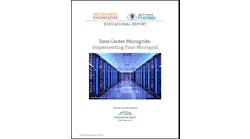It’s unclear what’s ahead for federal policy on microgrids and distributed energy with the changing of the guard in Washington, D.C. But the Obama administration pushed the resources in its final energy blueprint issued last week.
“Transforming the Nation’s Electricity System,” the second installment of the Department of Energy’s Quadrennial Energy Review looks at the rapid technology overhaul on the grid and the challenges that result.
The 500-page report sets out 76 recommendations covering a broad range of energy issues. Specific to microgrids and distributed energy, they include:
The report points out ways the federal government can help microgrids and distributed energy from a technical, market and regulatory position.
For example, it recommends that a federal advisory committee look at ways to harmonize retail and wholesale electric rates. Among other things the committee would explore state and federal roles in pricing and operation of distributed energy, energy storage, and microgrids.
The report also points out a lack of organized commodity markets for distributed energy. This may change over time, the report says, and points to New York’s Reforming the Energy Vision (REV) as a possible model.
The report also calls for leveraging existing DOE programs to provide technical assistance in development of microgrids, distribution management systems, communications and sensors, energy storage and cybersecurity.
Managing new complexity
New technologies bring consumer benefits, but also create complexity on the grid, says the report.
The report describes ‘variable energy resources’ as an example. VERs “provide a range of benefits to utilities and their customers, including avoided fuel costs, greenhouse gas emissions, and costs associated with environmental compliance,” said the QER second installment. “In some cases, distributed VERs are also credited with providing electric reliability and resilience benefits, particularly in the context of microgrids.”
At the same time, widespread integration of variable energy, both on the utility and distributed scale, “significantly expands the time dimensions in which grid operators must function, and it complicates operations,” the report says.
This underscores the need for greater time and space coordination within the electric grid and a “a reimagining of electricity grid management,” according the report.
Microgrids offer a quick approach to managing reliability, since they can step in to provide power when the sun doesn’t shine, wind doesn’t blow, or some other variable quickly disrupts electric generation on the grid.
Prices fall for clean energy
Separately, Ernest Moniz, U.S. energy secretary, released an exit memo last week that cites changes over the last eight years in the nation’s energy picture. These include:
- Solar grew from 1.2 GW to 31 GW and wind energy from 25 GW to 75 GW
- The cost of battery energy battery storage decreased 70 percent
- Nearly 30 electric vehicle (EV) models are available, up from only one in 2008. More than a dozen manufacturers now produce EVs. Total sales of EVs approached the half million mark as of August 2016.
- Publicly accessible EV charging expanded from 500 to 16,000 stations
- The cost of LED lightbulbs dropped by 94 percent
- Fifty new energy efficiency standards are expected to save consumers $550 billion on their energy bills and avoid about three billion tons of carbon dioxide emissions by 2030
The full Quadrennial Energy Review is available on the DOE website.







